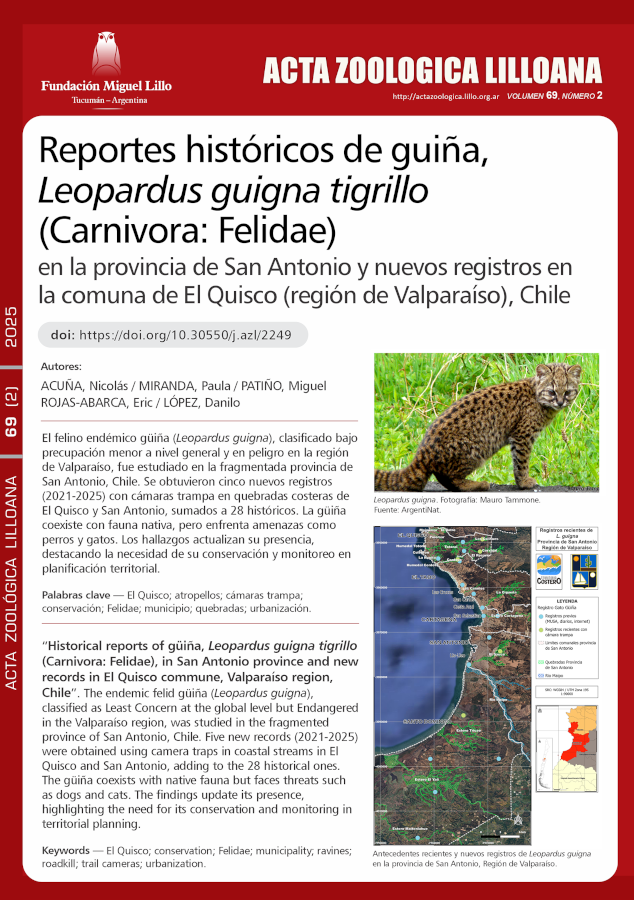Historical reports of güiña, Leopardus guigna tigrillo (Carnivora: Felidae), in San Antonio province and new records in El Quisco commune, Valparaíso region, Chile
DOI:
Keywords:
El Quisco, Conservation, Felidae, Muncipality, Ravines, Roadkill, Trail Cam, UrbanizationAbstract
Leopardus guigna, commonly known as güiña or kodkod, is a felid endemic to the temperate forests of southern South America, currently classified as Vulnerable by the IUCN. Its presence in central Chile has been scarcely documented, particularly in San Antonio Province (Valparaíso region), where urban development has led to severe habitat loss. This article presents historical records of the species and new detections obtained between 2021 and 2025 through camera trap surveys conducted in coastal ravines within the communes of El Quisco and San Antonio. Monitoring campaigns were conducted with and without scent lures, recording species presence, behavior, co-occurrence with native fauna, and threats such as free-ranging domestic dogs and cats.
Recent detections were recorded in Quebrada de Córdova, Los Colihues, and Carvajal (El Quisco), as well as Fundo Llolleo (San Antonio), alongside 28 historical records within the province. Ravines with vegetation cover, water flow, and ecological connectivity emerged as key habitats and potential ecological corridors for the species. In areas with lower anthropogenic pressure, such as Fundo Llolleo, no domestic dogs were detected, contrasting with more urbanized ravines. The co-occurrence of güiña with other native species suggests complex trophic interactions. These findings expand current knowledge of the güiña’s distribution in central Chile and emphasize the need to incorporate its conservation into territorial planning. Furthermore, the results underscore the importance of sustained monitoring to assess population viability in fragmented landscapes.
Downloads
References
Altamirano, T. A., Hernández, F., De la Maza, M., & Bonacic, C. (2013). Güiña (Leopardus guigna) preys on cavity-nesting nestlings. Revista Chilena de Historia Natural, 86, 501–504. https://www.researchgate.net/publication/276017042_Guina_Leopardus_guigna_preys_on_cavity-nesting_nestlings
Correa, P., & Roa, A. (2005). Relaciones tróficas entre Oncifelis guigna, Lycalopex culpaeus, Lycalopex griseus y Tyto alba en un ambiente fragmentado de la zona central de Chile. Mastozoología Neotropical, 12, 57–60. https://www.researchgate.net/publication/26420525
Dunstone, N., Freer, R., Acosta-Jamett, G., Durbin, L., Wyllie, I., Mazzolli, M., & Scott, D. (2002). Uso del hábitat, actividad y dieta de la güiña (Oncifelis guigna) en el Parque Nacional Laguna San Rafael, XI Región, Chile. Boletín del Museo Nacional de Historia Natural, 51, 147–158. https://publicaciones.mnhn.gob.cl/668/articles-64480_archivo_01.pdf
Gálvez, N., Hernández, F., Laker, J., Gilabert, H., Petitpas, R., Bonacic, C., Gimona, A., Hester, A., & MacDonald, D. (2013). Forest cover outside protected areas plays an important role in the conservation of the vulnerable guiña Leopardus guigna. Oryx, 47(2), 251–258. https://doi.org/10.1017/S0030605311001841
Gálvez, N., Bañales, C., & Schüttler, S. (2019). Guía de monitoreo escolar de fauna silvestre mediante fototrampeo. https://www.researchgate.net/publication/344655192
Guzmán-Marín, B., Hernández-Hernández, J., & Aguilera, N. (2022). New records of the kodkod (Leopardus guigna tigrillo) and the Pampas cat (Leopardus colocola) in Valparaíso region, Chile. Therya Notes, 3, 41–45. https://doi.org/10.12933/therya_notes-22-67
Luebert, F., & Pliscoff, P. (2006). Sinopsis bioclimática y vegetacional de Chile. Editorial Universitaria. http://dx.doi.org/10.4067/S0718-34022008000200008
Napolitano, C., Sanderson, J., Johnson, W. E., & Vázquez, R. (2015). Leopardus guigna. The IUCN Red List of Threatened Species 2015: e.T15311A50657245. https://doi.org/10.2305/IUCN.UK.2015-4.RLTS.T15311A50657245
Napolitano, C., Larraguibel-González, C., Cepeda-Mercado, A. A., Muñoz-Pedreros, A., & Sanderson, J. G. (2020). New records of Leopardus guigna in its northern-most distribution in Chile: Implications for conservation. Revista Chilena de Historia Natural, 93, 7. http://dx.doi.org/10.1186/s40693-020-00095-8
Osgood, W. H. (1934). The mammals of Chile (Vol. 30). Field Museum of Natural History. https://www.biodiversitylibrary.org/part/96711
Schüttler, E., Klenke, R., Galuppo, S., Castro, R. A., Bonacic, C., Laker, J., & Henle, K. (2017). Habitat use and sensitivity to fragmentation in America’s smallest wildcat. Mammalian Biology, 86, 1–8. https://doi.org/10.1016/j.mambio.2017.03.00
Downloads
Published
How to Cite
Issue
Section
License
Copyright (c) 2025 Acta Zoológica Lilloana

This work is licensed under a Creative Commons Attribution-NonCommercial-NoDerivatives 4.0 International License.









